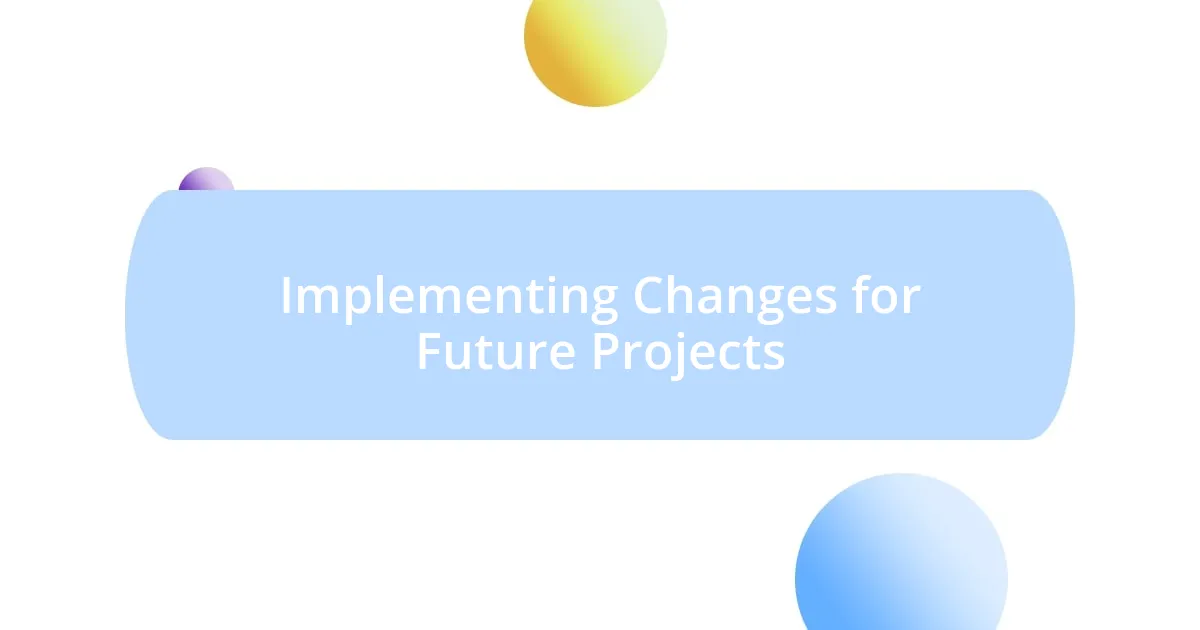Key takeaways:
- Understanding project outcomes involves evaluating both tangible and intangible impacts, emphasizing emotional connections and stakeholder feedback.
- Regular evaluation of outcomes fosters continuous improvement, enhances project authenticity, and strengthens team cohesion through transparency.
- Effective data collection combines quantitative metrics with qualitative insights, using tools like surveys and focus groups for deeper understanding.
- Analyzing results requires contextual interpretation and team collaboration to uncover patterns, engage stakeholders, and adapt strategies for future success.

Understanding Project Outcomes
Understanding project outcomes goes beyond just measuring success with numbers. I remember a project I led where we met all our deadlines and stayed on budget, but the final product didn’t resonate with the intended audience. It was a heart-wrenching realization because achieving the technical goals didn’t mean we fulfilled the project’s true purpose. How often do we prioritize metrics over the feelings and needs of our stakeholders?
Outcomes can be both tangible and intangible, which can make evaluation tricky. For instance, in a community outreach project I was involved in, we collected impressive data on attendance, but the real outcome—strengthening community bonds—was harder to quantify. Reflecting on this, it’s clear to me that emotional connections and feedback often provide the rich context we need to truly understand our project’s impact.
When evaluating project outcomes, I’ve found it helpful to ask, “What change are we actually creating?” This simple question has guided my teams to look beyond surface metrics and delve deeper into the real-life implications of our work. It’s a journey, and each project teaches us something unique about what it means to succeed.

Importance of Evaluating Outcomes
Evaluating outcomes is crucial because it helps us grasp the authenticity of our efforts. I once participated in a project where we followed what seemed like a perfect plan, but the feedback from the participants revealed dissatisfaction. This contrast highlighted how we can sometimes get lost in the details and forget to listen to the people we serve. It was a tough lesson for me, but it reinforced the idea that success isn’t just about completing tasks—it’s about making a lasting impact.
Additionally, evaluating project outcomes allows for continuous improvement, which is vital in any field. I remember an initiative where we gathered feedback after implementation. The insights revealed areas for adjustment that we had overlooked, ultimately leading to enhancements in future projects. By regularly reflecting on outcomes, we not only fine-tune our current efforts but also set the stage for future achievements. It’s like having a compass; without it, we might wander off course.
Lastly, understanding the importance of evaluating outcomes can unite a team. When we share our evaluations openly, it creates a culture of transparency and accountability. I’ve seen firsthand how team discussions about project successes and failures deepen trust and collaboration. It’s these moments of sharing that often foster the strongest connections between team members, making the evaluation process not just about numbers but about our shared growth.
| Aspect | Importance of Evaluating Outcomes |
|---|---|
| Project Authenticity | Captures the true impact beyond metrics. |
| Continuous Improvement | Facilitates adjustments for future projects. |
| Team Cohesion | Fosters transparency and strengthens collaboration. |

Key Metrics for Evaluation
When I think about key metrics for evaluation, I often reflect on how they can dramatically influence our perspective on success. One project I was involved in focused on improving education resources in underprivileged areas. We tracked metrics like test scores and teacher attendance. While these numbers gave us a glimpse into progress, they missed the heart of the matter. The stories of students’ newfound enthusiasm for learning were far more compelling than any statistic.
To truly evaluate a project’s outcome, consider these key metrics:
- Engagement Levels: Measure how involved your target audience is during the project.
- Satisfaction Ratings: Collect feedback through surveys to assess how well the project met stakeholder expectations.
- Behavioral Changes: Look for shifts in actions or attitudes post-project.
- Return on Investment (ROI): Analyze financial inputs versus tangible outcomes to understand economic impact.
- Long-Term Impact: Evaluate the sustainability of project benefits over time.
I’ve learned that relying solely on numeric data can sometimes cloud our judgment. For instance, in a health initiative, we meticulously measured attendance at workshops, convinced that higher numbers equated to success. Yet, the real victory was in the heartfelt testimonials about how participants felt empowered to take charge of their health. These moments remind me to cherish both the numbers and the narratives, as they each have their own story to tell.

Tools for Measuring Success
Measuring success is not just about numbers; it’s about finding the right tools that align with our project’s goals. One of my go-to tools has been the use of project management software. It not only keeps everyone on track, but it also allows for real-time data analysis. I remember using a platform that provided snapshots of milestones and deliverables. The instant feedback we received was invaluable, helping us pivot when needed, almost like having a map guiding us through uncharted territory.
Surveys are also a powerful tool for gauging success. In a community outreach project I ran, simple questionnaires helped us gather qualitative insights. I was surprised by how open participants were in sharing their experiences; their reflections revealed layers of impact that numbers alone couldn’t capture. Does that resonate with you? I had to remind myself that behind every statistic lies a human story—something that can truly illuminate the effectiveness of our efforts.
Another fascinating tool I discovered is the implementation of focus groups post-project. I had the opportunity to facilitate a discussion with key stakeholders after a recent initiative. It was eye-opening to hear their thoughts and feelings, and I was struck by how nuanced their perceptions were. Their feedback wasn’t just about what worked or what didn’t; it was about what they valued most. Could you imagine the depth of understanding we gained from that? By engaging with those directly affected by your project, you gain insights that are often overlooked in traditional evaluations, making it a treasured tool in my measurement arsenal.

Collecting Data Effectively
Collecting data effectively requires a thoughtful approach, combining both quantitative and qualitative methods. I remember a project where we aimed to improve community health. Alongside hard data, such as clinic visit frequency, we used storytelling sessions to capture people’s experiences. Those narratives enriched our understanding and highlighted the emotional aspects of health that numbers often miss. Have you ever considered how personal stories can breathe life into statistics?
Utilizing technology can significantly enhance data collection. In another initiative, we implemented mobile surveys to capture immediate feedback from participants during events. The ease of accessing their thoughts in real-time created a dynamic flow of information. It felt like having a two-way conversation, and the instant responses helped us tweak our approach on the spot. I found that engaging directly with the audience can reveal insights that traditional methods might overlook—what’s your experience with tech in data gathering?
Observing behaviors in real-world settings also plays a crucial role in effective data collection. I once shadowed participants during a workshop instead of just sending out post-event surveys. Watching how they interacted and what engaged them most provided critical context. I could see first-hand the moments of connection that transformed knowledge into action. By immersing myself in their experience, I discovered that firsthand observations can illuminate the subtle nuances that pure data may fail to capture—doesn’t that add a whole new dimension to understanding project outcomes?

Analyzing Evaluation Results
Analyzing evaluation results goes beyond mere examination; it’s about interpreting the stories behind the data. In one project I evaluated, I discovered an unexpected trend: while the numbers looked promising, the underlying feedback revealed deep dissatisfaction among a segment of participants. It made me rethink the importance of context. I learned that presenting data without understanding the “why” leads to incomplete insights. Isn’t it enlightening how a number can reflect a reality that contradicts our expectations?
When scrutinizing outcomes, I find it beneficial to engage with team members who contributed to the project. During a recent analysis, I initiated a brainstorming session where we reviewed the results together. The conversations illuminated perspectives I hadn’t considered, such as the nuances in participant engagement. I realized that involving the team not only enriches our understanding but also fosters a sense of ownership over the results. How often do we overlook the knowledge of those right in the trenches?
I also prioritize identifying any patterns or anomalies in the data that might not be immediately obvious. For instance, when reviewing a community initiative, I noted a decline in engagement among younger demographics. Instead of brushing it aside as merely a statistical anomaly, I proposed a focused discussion to delve deeper. Ultimately, we realized we needed to adapt our approach to meet their interests more effectively. Isn’t it fascinating how a little curiosity can reveal solutions that lead to greater impact? This experience reinforced my belief that analyzing evaluation results is as much about dialogue as it is about metrics.

Implementing Changes for Future Projects
Implementing changes for future projects is crucial for continuous improvement. I remember a time when my team faced significant challenges during a community outreach program. After evaluating our methods, we realized that the timing of our events conflicted with local schedules. This insight prompted us to reach out to community members for their input, ultimately helping us adjust our strategy. Have you ever noticed how involving your audience in decision-making leads to a more relevant approach?
Another key lesson I’ve learned is the importance of being flexible in your methodology. In a project focused on education, we initially implemented a rigid curriculum based on outdated feedback. However, once we allowed participants to suggest adjustments, we fostered a more engaging and effective learning environment. This experience taught me that adaptability can transform a mediocre program into a thriving initiative. Isn’t it amazing how small tweaks can yield significant results?
Training your team to embrace a culture of feedback is also vital. In one project, I encouraged open discussions after each phase, allowing everyone to voice their thoughts—both positive and negative. This not only made us more cohesive as a group but also cultivated a safe space for innovation. I can still remember one team member’s suggestion that altered the project’s trajectory entirely. How often do we underestimate the power of encouragement in fostering creativity within our teams?














